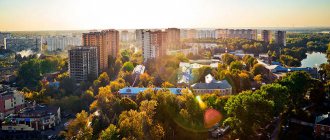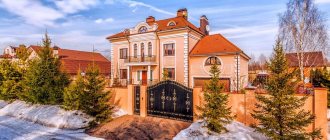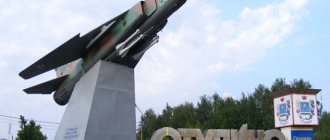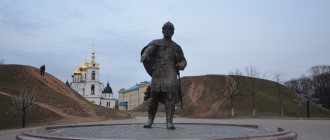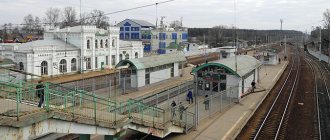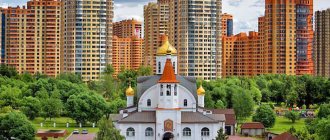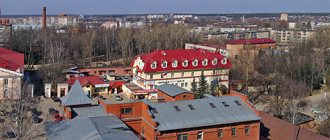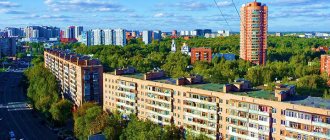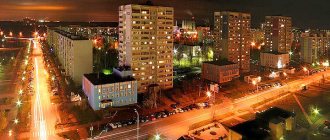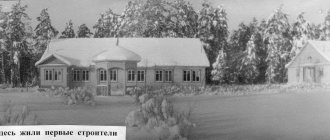Troitsk is located 18 kilometers from the Moscow Ring Road along the Kaluga Highway. This distance to Moscow can be covered by personal transport or by bus (minibus) going to the Teply Stan metro station; there is no railway in Troitsk.
The city itself has an interesting history. In 1627, the chronicle mentions Trinity Heath, which became a village 20 years later thanks to the construction of the Trinity Church. The village residents were engaged in weaving; it is not surprising that a woolen factory was founded here, which became one of the most advanced in Russia at that time.
Features of real estate in Troitsk
The city has an atypical layout. It is divided into blocks with letter designations, and each house has its own numbering. Therefore, do not be surprised if the number of your future house is: G-53 or B-18.
Troitsk is a young city, with virtually no dilapidated and obsolete housing. The peak of housing construction occurred in the 2000s, when modern, mostly monolithic brick houses were built in Troitsk in large quantities.
Therefore, today the demand is no longer so great, you can choose the optimal housing for yourself in terms of price-quality ratio, and over the past decade the infrastructure has also grown, especially in those neighborhoods where construction was completed earlier.
One cannot fail to note the amazing cleanliness of the roads and the city as a whole. Troitsk is closely monitoring this and we can say that they have dealt with this problem.
Territorial division of Moscow
There are 12 administrative districts in Moscow:
- Central administrative district.
- Western administrative district.
- Northwestern Administrative District.
- Northern administrative district.
- North-Eastern Administrative District.
- Eastern administrative district.
- South-Eastern administrative district.
- Southern administrative district.
- Southwestern administrative district.
- Novomoskovsk administrative district.
- Trinity administrative district.
Muscovites often determine their approximate location by the cardinal direction, which is associated with the names of the districts. For example: “Where are you? In North-west!"
Below in the diagram you can see the location of the districts.
Map of Moscow with administrative districts
Each of the districts includes districts, of which there are 125 in the city! In 2012, there was a major expansion of the city, resulting in the creation of two new districts, as well as a new administrative unit - settlements. Settlements are “new areas” that were previously small cities or towns, but when the city expanded, they became part of Moscow. There are currently 21 such settlements in Moscow.
Most counties have over a million people. And in total, according to official data, as of January 1, 2019, 12,659,279 people live in all districts of Moscow. Of course, the real number of people actually living is higher, since many live without temporary registration.
Infrastructure
Troitsk has several medical hospitals, a modern diagnostic center, many pharmacies and clinics. There are schools, a lyceum, a sports school and an art school, branches of the strongest universities (MSU, MIPT, MEPhI). Residents of the city have access to a cinema, a variety of hobby classes, a fitness club, swimming pools and a Sports Palace.
It was once calculated that three out of a hundred people in Troitsk are candidates or doctors of science. It is not surprising that the entertainment in the city is appropriate, for example, the physical cabinet of curiosities, where physical laws are presented in a playful form, there are unusual installations and art objects.
In the same city there is a monument to a junior researcher (popularly called the Harry Potter monument) - a granite cube and glasses, well, you can’t deny the author’s resourcefulness and sense of humor.
Troitsk
The settlement of Troitsk is a settlement and urban district within the Troitsky administrative district of Moscow, 20 km southwest of the Moscow Ring Road along the Kaluga Highway.
Until July 1, 2012, Troitsk was a city of regional subordination of the Moscow region, since 2007 it has the status of a science city. On July 1, 2012, it was included in Moscow during the implementation of the project to expand the capital. From the point of view of administrative division, Troitsk is a settlement, and from the municipal division it is a city district.
Population - 37.6 thousand inhabitants (according to Rosstat for 2010).
Historical reference
The city has a history dating back to the 17th century. Troitsk inherited its name from the ancient village of Troitsky, located on the site of the northern part of the modern city. Troitskoye was adjacent to the settlements of Butakovo (Batakovo/Botakovo) and Bogorodskoye. These names still exist on the territory of modern Troitsk.
In the scribe's book of 1627 there is the first mention of the Troitskaya wasteland as the ancient patrimony of the boyar I. I. Saltykov.
In 1674–1675 the owner of the neighboring village of Vatutina, Prince I.B. Repnin, built a stone church not far from Troitsky on the high right bank of the Desna, after its name this village was called Bogorodsky.
In 1700, L. I. Saltykov gave the village of Troitskoye with the neighboring village of Butakovo to his daughter and her husband, Prince P. G. Shcherbatov.
In 1751, the owner of the village, Ya. M. Evreinov, began to build a linen enterprise in the village, on the basis of which, presumably, a factory later arose.
Science City
Today there are ten well-known research centers in Troitsk, which employed 12 thousand people in Soviet times. Institutes have become a city-forming factor for Troitsk. Today, less than 5 thousand people from among the city’s residents are involved in scientific work, research and development.
Economy
Currently, the city has a developed infrastructure, including modern housing, shops, consumer services, healthcare, kindergartens, secondary schools, a lyceum, two gymnasiums, and a sports school.
In recent years, intensive housing construction has been underway in Troitsk, and therefore a sharp increase in the number of city residents is expected. New residents are attracted by the favorable environmental situation in the city (surrounded by forests and there are no large industrial enterprises) and proximity to Moscow. Due to the heavy congestion of the Kaluga Highway, traffic jams are possible during rush hours. To prevent the city from turning into a “dormitory” area of Moscow, projects are being developed to create high-tech industries and build a campus for the State University - Higher School of Economics.
Attractions
- Lilac Boulevard. Pedestrian street with many playgrounds and fountains.
- Monument to a junior researcher on Sirenevy Boulevard.
- Trinity Worsted Factory. The building of the water tower and the dam on the Desna River have been preserved.
- Temple in the name of the Tikhvin Icon of the Mother of God (early 18th century)
- Desna River
Climate
The climate is temperate continental. The average temperature in January is ?10.8, in July +17.2.
Culture
The historically established specifics of the city are such that the number of residents with higher education is much higher than the national average, which determines the high cultural level of city life.
For children and teenagers, the city has music and art schools, an Art School, dance and sports sections. In addition, young people have the opportunity to engage in scientific work in the “Baytik” computer club and natural science sections.
For concerts, performances, meetings with interesting people, there are cultural centers of the city - the Center for Culture and Creativity, the House of Scientists of the Trinity Scientific Center of the Russian Academy of Sciences, the Cultural and Technical Center of the Trade Union Committee of TRINITY (the youth committee of the city). In 2007, the Kvant Sports Palace was put into operation, which hosts both sporting events at the regional and all-Russian level, as well as mass cultural events - the III International Jazz Festival "Jazz-Moskovia" (September 2007), concerts and competitions with participation of groups from the city and region, discos.
City events are covered by local television () and the press (newspapers “Troitsky Variant”, “Gorodskoy ri”).
Among the creative groups of the city one can highlight the Big Band under the direction of Viktor Gerasimov, the Trinity Chamber Choir (conductor and artistic director Alexey Maly), the Dance Ensemble of the Trinity City House of Scientists (director Galina Goleneva), the Children's Theater-Studio of Classical Dance "Blue Bird" (director Diana Muradyan), the ensemble "Russian Ballad" (director Lyudmila Shaulina) and the "People's Collective" children's theater-studio "Balaganchik" under the direction of Nadezhda Alekseevna Volokitina.
In 2008, the Children's School of Arts named after M. I. Glinka was opened, where music, art and dance departments function.
Who are the main home buyers in Troitsk?
An intelligent and educated environment is what awaits those who choose new buildings in Troitsk. Development companies and realtors have estimated that about 65% of apartments in new buildings in the city are bought by Muscovites who want to improve their living conditions, about 20% are purchased by residents of Troitsk itself and the rest by representatives of the regions.
There are also Muscovites who live in Moscow and come to Troitsk Science City to work. So Troitsk is so involved in business and scientific turnover, so closely connected with the capital, that it rightfully bears the name of the capital urban district.
Moscow City Duma deputy Mitrokhin found sites in Troitsk where several schools can be built without cutting down forests
The struggle to preserve the Trinity Forest has been going on for several years, and after the area was annexed to New Moscow, it became even more active. On the site of the green area, it is planned to build a school for 2,100 places with a swimming pool, stadium and parking space, as well as a four-lane road. Local residents believe that there is plenty of free space in the city for the construction of an educational institution without deforestation
This week, despite the round-the-clock watch of an initiative group of citizens, the developer still cut down several dozen trees. The work continued in the evening and at night, when a conflict arose between the builders and environmental activists. During the brawl, I had to fight not only for the forest, but also for my own health. As one of the participants in the incident said, physical force was used against the forest defenders by the guards, who had previously communicated exclusively in raised voices. None of them, according to the publication’s interlocutor, presented documents, and any requests were answered with insults. The police arrived only two hours after the first call, and, the activist noted, there were several of them. The resident himself was also among the victims.
“After the injuries I received, I went to the city emergency room. The doctor, without examining me, gave me a piece of paper indicating that I needed to make an appointment with a therapist so that he could prescribe treatment. Tomorrow I and two other victims will go to a Moscow hospital, where we will be examined,” the man said.
Activists continue to write appeals to all possible authorities. On February 5, Moscow City Duma deputy Sergei Mitrokhin attended the next gathering of Troitsk residents. The parliamentarian announced plans to send a parliamentary request to Moscow Mayor Sergei Sobyanin asking residents to stop cutting down trees.
The politician talked with activists and asked them to collect and transmit information about possible violations that were committed during public hearings (and, according to citizens, there were a lot of them). Together with the townspeople, he visited several alternative sites that could be used for the construction of a school.
As Mitrokhin noted, next week he plans to meet with the head of the city district Dudochkin (previously, Troitsk residents called on the Moscow mayor to remove the latter from his position) and again raise the topic of aggressive development and discuss alternative construction sites.
“I visited places in Troitsk where you can build more than one school without cutting down forests. I agreed with the head of SU 555 to suspend work until Monday until I call the head of the Department of Urban Development Zhidkin,” the politician wrote on his blog on Telegram, adding that he would also prepare a separate appeal addressed to Oleg Baranov (head of the Main Directorate of the Ministry of Internal Affairs of Moscow - approx. .ed.) regarding the beating of residents by unknown persons during the confrontation and the corresponding reaction of police officers.
Moscow City Duma deputy Evgeny Stupin noted that it is too early to draw hasty conclusions in the story of the deforestation of the Trinity Forest. “The situation is still developing, there are no final solutions, the forest is being cut down, but it has not been cut down yet, so there is a chance to stop all this. For my part, I have already sent relevant requests to the chief of the Moscow police, the Moscow prosecutor and the mayor of Moscow Sergei Sobyanin. I hope that mass attention will produce results,” said Evgeny Stupin in a conversation with a journalist from Moskovskaya Gazeta.
The Saturday meeting in the forest ended with a traditional concert performed by local residents and folk festivities. On February 6, activists plan to discuss pressing problems with Deputy of the State Duma of the Russian Federation Denis Parfenov.
Meanwhile, messages about the exceptional advantages of building a new school are being circulated in Telegram channels.
“Most of the townspeople are in favor because they need a school. But a small group, as always, is against it. And there is more noise from this group than from the rest of the city,” wrote the channel of journalist Maxim Kononenko.
Some sources even call opponents of deforestation idiots, and also propose to allocate several places in the new school in order to teach them logic.
Western administrative district of Moscow
The Western Administrative District is the second most expensive real estate after the center. This is due to many factors. Firstly, this is one of the oldest districts of the city with well-developed infrastructure. Secondly, it is home to the legendary Moscow State University and other higher education institutions. Thirdly, it is conveniently located geographically. And fourthly, it is simply very prestigious.
Almost 1.4 million people live in the Western District. And guess where it is? That's right, you guessed it - in the west of the city.
The district includes 13 districts: Vnukovo, Krylatskoye, Mozhaisky, Ochakovo-Matveevskoye, Vernadskogo Avenue, Solntsevo, Filyovsky Park, Dorogomilovo, Kuntsevo, Novo-Peredelkino, Ramenki, Troparevo-Nikulino, Fili-Davydkovo.
Districts of the Western Administrative District of Moscow on the map
Central administrative district of Moscow
Ooo! This is the legendary historical center of Moscow with a rich history. Indescribably beautiful and experienced a huge number of both terrible and joyful events. It is home to 782 thousand people.
Central includes 10 districts: Arbat, Basmanny, Meshchansky, Khamovniki, Tverskoy, Tagansky, Presnensky, Zamoskvorechye, Krasnoselsky, Yakimana. Sometimes you can hear about Kitay-gorod, but territorially it belongs to the Tver district.
Central district of Moscow and its areas
The Central District has the most expensive real estate. Here are the most famous sights of Moscow, such as the Kremlin, Red Square, the already legendary Moscow City complex, Zaryadye Park and others.
The Central District is the dream of life for many people, but there are also disadvantages. Constant bustle, a huge number of people, sky-high housing prices. Many streets are often blocked due to city events.
